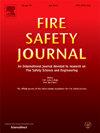Environmental impact of sprinklers and gravity smoke vents interaction — Review and probabilistic modelling approach
IF 3.4
3区 工程技术
Q2 ENGINEERING, CIVIL
引用次数: 0
Abstract
In the event of a fire in a typical industrial building, the systems deployed first are sprinklers and gravity smoke vents. Scientists and experts have not reached a firm consensus on the advantages or disadvantages of using sprinklers and gravity smoke vents together. While life-safety and property protection aspects have been already investigated, the environmental impact of these interactions has not yet been considered in research. This study identified and meticulously analysed several environmental issues related to the cooperation of these FPSs. A probabilistic model was then developed to efficiently assess emissions of selected pollutants from fires. The focus was on priority pollutants in terms of climate, toxicity and carcinogenicity. Various cost-optimization and monetization techniques were assessed to propose an appropriate method for evaluating the environmental impact of FPSs. A generic warehouse case study was conducted, comparing 24 different storage and FPS configurations. The applicability of the proposed approach was confirmed; however, the case study results indicates that the interference between sprinklers and gravity smoke vents is relatively insignificant compared to other factors. Additionally, four configurations of sprinklers and vents application were analysed. Sprinklers only have the lowest impact on environment for generic warehouse.

洒水喷头和重力排烟口相互作用对环境的影响。回顾和概率建模方法
在典型的工业建筑发生火灾时,首先部署的系统是洒水装置和重力排烟口。科学家和专家们还没有就同时使用喷头和重力排烟口的利弊达成坚定的共识。虽然已经对生命安全和财产保护方面进行了调查,但这些相互作用的环境影响尚未在研究中得到考虑。这项研究确定并仔细分析了与这些FPSs合作有关的几个环境问题。然后开发了一个概率模型,以有效地评估火灾产生的选定污染物的排放。重点是气候、毒性和致癌性方面的优先污染物。评估了各种成本优化和货币化技术,提出了评估FPSs环境影响的适当方法。进行了一个通用仓库案例研究,比较了24种不同的存储和FPS配置。验证了所提方法的适用性;然而,实例研究结果表明,与其他因素相比,喷头与重力排烟口之间的干扰相对较小。此外,还分析了四种喷头配置和通风口的应用。洒水装置对一般仓库的环境影响最小。
本文章由计算机程序翻译,如有差异,请以英文原文为准。
求助全文
约1分钟内获得全文
求助全文
来源期刊

Fire Safety Journal
工程技术-材料科学:综合
CiteScore
5.70
自引率
9.70%
发文量
153
审稿时长
60 days
期刊介绍:
Fire Safety Journal is the leading publication dealing with all aspects of fire safety engineering. Its scope is purposefully wide, as it is deemed important to encourage papers from all sources within this multidisciplinary subject, thus providing a forum for its further development as a distinct engineering discipline. This is an essential step towards gaining a status equal to that enjoyed by the other engineering disciplines.
 求助内容:
求助内容: 应助结果提醒方式:
应助结果提醒方式:


